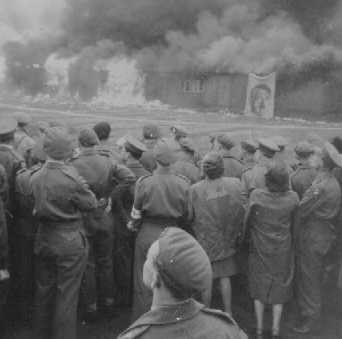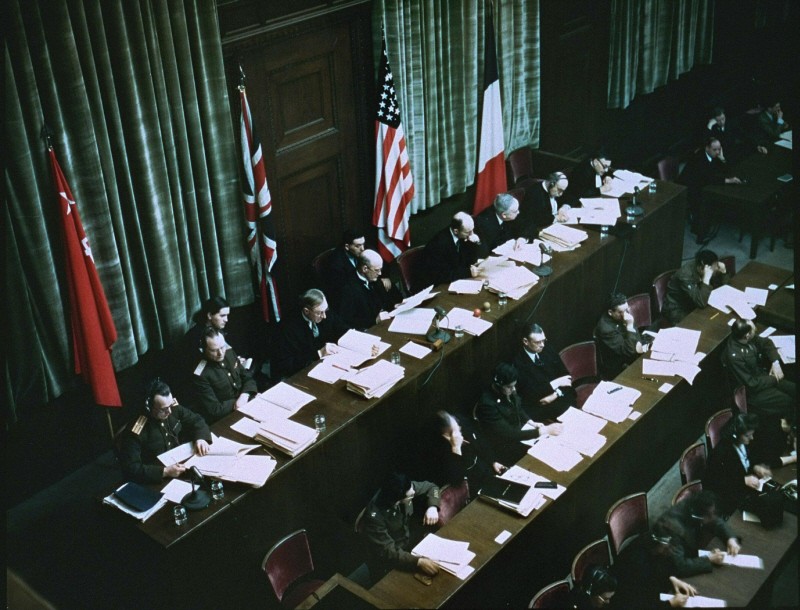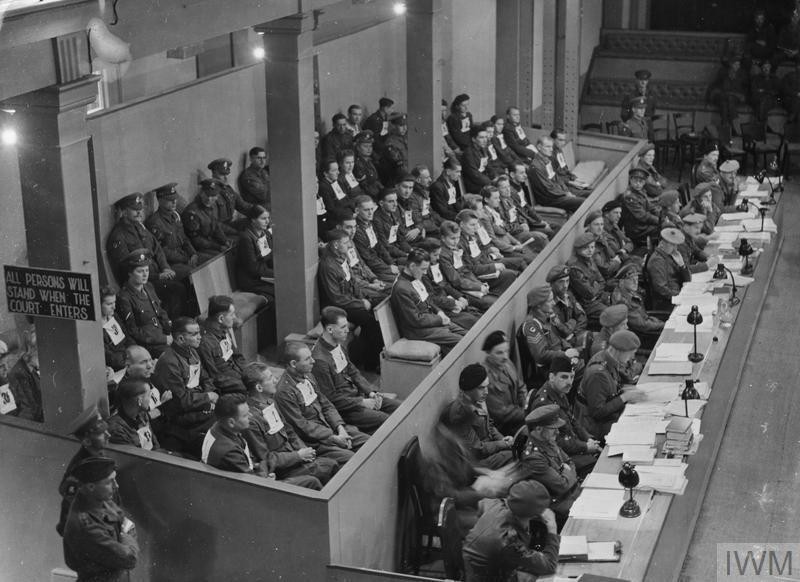
Bergen-Belsen Trial
British forces liberated the Bergen-Belsen concentration camp in April 1945. British troops sent reports back home documenting conditions in the camp. These reports shaped much of British popular understanding about Nazi atrocities. Beginning in September 1945, the Belsen Trial was one of the earliest war crimes trials held after World War II. The British were eager to “go first” with the Belsen Trial as one of the first postwar trials.
Key Facts
-
1
The Belsen Trial was a British, rather than Allied, trial. The British Army tried the case under a British legal document known as the Royal Warrant in their zone of occupation.
-
2
The trial began on September 17, 1945 and lasted 54 days. During the proceedings, 45 people were tried for crimes committed at both Bergen-Belsen and Auschwitz.
-
3
Eleven defendants were sentenced to death. Nineteen defendants were given prison terms ranging from life to one year, and fourteen were acquitted. One defendant became sick and was not tried.
Liberation of Bergen-Belsen and Arrests of Camp Personnel
The British Army liberated the Bergen-Belsen concentration camp in April 1945. Immediately, British troops began sending reports back home documenting conditions in the “horror camp.” Belsen was the only major concentration camp liberated by the British. As such, Belsen shaped much of British popular understanding about Nazi atrocities.
By September 1945, the British Army had arrested 45 individuals for the “death or physical suffering” of victims at Bergen-Belsen between October 1942 and April 1945. Of the 45, 24 were men and 21 were women. Furthermore, 35 were SS personnel, and 10 were Kapos.
The British were eager to “go first” with the Belsen Trial as one of the first postwar trials, partly due to public outrage at Nazi atrocities and partly for strategic geopolitical reasons.
Postwar Trials

The International Military Tribunal (IMT) at Nuremberg is the best-known postwar trial. It was prosecuted under the Allied authority of the Nuremberg Charter.
Each Allied power also held dozens of separate trials in their own occupation zones. Each power set up their own processes for war crimes trials, distinct from the IMT. One of the first war crimes trials was the Bergen-Belsen Trial. It was tried by the British military.
British authorities staged their trials using the Royal Warrant of 1945. This warrant allowed the British Army to prosecute “violation[s] of the laws and usages of war committed during any war in which His Majesty has been or may be engaged at any time since 2nd September 1939.” The Royal Warrant allowed the British to try war crimes, but not crimes against humanity. The charge of war crimes had precedent under international law. Meanwhile, crimes against humanity had no existing definition in 1945.
The Belsen Trial
The trial began on September 17, 1945, at Lüneburg in northern Germany in the British zone of occupation. The trial preceded the beginning of the IMT by two months and lasted 54 days. There was intense press interest. Deputy Judge Advocate General Carl Ludwig Stirling, OBE, CBE, QC presided. Colonel T.M. Backhouse and Major H.G. Murton-Neale argued the British case for the prosecution. Eleven British soldiers and one Polish soldier represented the defendants. The court called over a hundred witnesses, including 121 camp survivors.
The prosecution made three primary arguments.
- First, that every action at Belsen and Auschwitz violated the Geneva Conventions. This “complete disregard for the sanctity of human life and for human suffering” meant every staff member, from Kommandant to Kapo, was responsible.
- Second, that all deaths at Belsen and Auschwitz, whether caused by living conditions, beatings, shootings, or gassings, were intentional and therefore murder.
- Third, that all defendants were individually responsible, but their crimes took place within a criminal system that could be held against each person.
Moreover, the prosecution was clear that Jews were targeted and killed because they were Jewish. As Colonel Backhouse stated in his closing remarks, “in Auschwitz … people were gassed for no other reason than that they were Jews.”
The Defendants
The defendants at the Belsen Trial included Belsen Kommandant Josef Kramer, known as the “Beast of Belsen,” SS doctor Fritz Klein, and Aufseherin (female guard) Irma Grese, the “Blonde Bitch of Belsen.” All 45 pleaded not guilty.
Twelve defendants also faced charges for crimes committed at Auschwitz. Since Auschwitz was not located in an Allied occupation zone, none of the four leading Allied powers could hold a trial there. But Auschwitz was so notorious that the British still wanted to bring its war crimes to trial. Since many of the SS stationed at Belsen had previously served at Auschwitz, the British could bring charges for both Belsen and Auschwitz under one trial.
There were practical reasons to include Auschwitz in the Belsen Trial. When Belsen was liberated, most of its survivors had been there for fewer than three months. This limited the testimony they could offer about Belsen. Most of their experiences during the war had been in other camps. Many of the staff were also recent transfers to Belsen but had long track records of crimes at other camps. Thus, including Auschwitz broadened the range of witnesses, experiences, and crimes the British could present at trial.
British officials would conduct two much smaller trials of Belsen personnel in their zone of occupation in June 1946 and April 1948, respectively.
Defense Arguments
Most of the defendants were still working at Belsen at the time of their arrest. Therefore, the most common defense argument centered on superior orders. The defendants argued they had followed orders from their superiors, rather than acted on their own initiative. Therefore, they were not responsible for their crimes.
Other defense strategies included:
- acknowledging the crimes at Belsen but denying any involvement in the acts
- challenging the witnesses’ memory
- and arguing that the British court had no right to try crimes against victims who were not Allied nationals
Verdict
The court deliberated for six hours before returning a verdict. Thirty defendants were found guilty of at least one charge at Belsen and/or Auschwitz. Fourteen were acquitted. One defendant became too sick to stand trial and was removed. The court eventually handed down eleven death sentences. They also gave nineteen prison terms ranging from life to one year. The death sentences, including those of Josef Kramer, Fritz Klein, and Irma Grese, were carried out on December 13, 1945, in the prison in Hamelin, Germany.
Public Reaction
Public reaction to the verdicts was mixed. British audiences were largely pleased with what they saw as a shining example of British justice for “a world that had almost forgotten what justice was.” Germans generally found the outcome more moderate than expected. The fourteen acquittals had come as a surprise. Most Germans had assumed anybody charged with war crimes would be found automatically guilty.
The verdicts deeply upset Jewish and survivor communities, as well as the French, Soviet, and Polish governments. They found the verdicts unacceptably lenient. Some struggled with the very idea of a fair trial for Nazis. This would continue to bother many during the IMT and other trials.
Footnotes
-
Footnote reference1.
Deposition of Captain Derrick Adolphus Sington, June 26, 1945, TNA, WO 309/17.
-
Footnote reference2.
United Nations War Crime Commission, Law Reports of Trials of War Criminals, vol. II (Stationary Office, 1947), 4.
-
Footnote reference3.
United Nations War Crime Commission, “Annex 1: British Law Concerning Trials of War Criminals by Military Courts,” in Law Reports of Trials of War Criminals, vol. I (Stationary Office, 1949), 105–110.
-
Footnote reference4.
Colonel T. M. Backhouse, “Opening Address for the Prosecution,” in Belsen Trial Transcript, September 17 1945, TNA, WO 235/13.
-
Footnote reference5.
Colonel T. M. Backhouse, “Closing Address for the Prosecution,” in Belsen Trial Transcript, November 13, 1945, TNA, WO 235/13.
-
Footnote reference6.
“Kramer and Grese Among the Belsen Guilty: How They Heard Their Verdicts, The Manchester Guardian, November 17, 1945.


